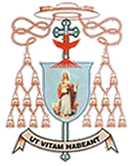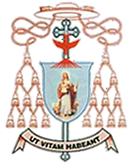(Priestly Ordination Homily by Archbishop Valerian M. Okeke September 26, 2020)
Introduction:
St. Paul declared in his epistle to the Galatians “it is no longer I who live but Christ who lives in me” (Gal 2 ;20). This statement applies to every baptized Christian more so to every Catholic priest. By his priestly calling and consecration, the priest is expected to be a living image of Jesus Christ, a visible sacramental presence of our Lord and Holy Redeemer.
We shall briefly look at; the events of the priestly ordination, The Eucharistic life of a Priest and the Priest who exercises Sacred Powers in the name of and the person of Christ.
- THE EVENT;
Priestly Ordination or Consecration:
This is one of the Sacraments called Holy Orders. Holy Orders is the sacrament through which the mission entrusted by Christ to his apostles continues to be exercised in the Church until the end of time. It is the sacrament of apostolic ministry which includes; Episcopacy, Presbyterate (i.e. Priesthood) and Diaconate. (CCC1536)… This sacrament contributes to the salvation of the individual recipient only through service. (Cf. CCC. 1534). It confers on the recipient the gift of the Holy spirit in a special way which permits him the exercise of Sacred Powers (Sacra Potestas).
Some of the rites include:
- Calling the Name:
The candidate is called and he responds. Through the call of his name the Lord through the Church reminds the candidates that it is the good Lord who is calling him. Priesthood is a gift from God. He calls and chooses; he makes worthy those he has called.
- The interrogation:
The candidate is asked among other questions. Are you resolved to consecrate your life to God for the salvation of his people and to unite yourself more closely every day to Christ the High priest, who offered himself for us to the father as a perfect Sacrifice?
- The affirmative response comes – Yes, I am by the grace of God. This confirms ones willingness to offer one’s life with Christ.. to continue the work of Christ. Also, this is willingness of the candidate to allow Christ continue his work through the priest. Pope Benedict xvi calls it total renunciation and self- abandonment.
- The vows especially the promise of obedience:
Through these, the candidate declares his readiness to live the evangelical councils; Poverty, Chastity and Obedience. Readiness to shun possessions, pleasure and power. It is giving up self and preferring Christ above all.
- The Litany of the Saints:
The Saints and heavenly bodies are invoked to come to our assistance. During this prayer, there is prostration. This prostration symbolizes ritual burial, total self-giving, self- emptying and spiritual bonding with God. The candidate is saying to God. Please take me!!! Total resignation.
This prayer also assures us of the protection and assistance of God’s saints. It is the Church invoking the saints to enroll the candidates as members of their constituency. Though still on earth in the flesh, they belong to the saintly group working for God. The saints are pleaded to accompany the candidate in his life and works as a priest –as a man consecrated to God. We are then encouraged with the consolation that the candidate is not alone, the prayers of God’s saints go with him. But this is also a reminder of our symbolic death, and total detachment and separation from the world. The priest now belongs to a different unit, a different life. When he rises from this “burial” he should live a new life – namely the life of Christ who has called him. With readiness to live this new life, the prayer of consecration follows.
- The Prayer of Consecration:
Among other supplications the Church prays for the candidates “as they give up their lives for God and for the salvation of their brothers and sisters, may they strive to be conformed to the image of Christ himself and offer you a constant witness of faith and love. They are to renew in your name the sacrifice of human redemption”. This prayer is also in the preface.
- The imposition of hands or the lying on of the Hands:
Through the imposition of hands by the Apostles Peter and John in the city of Samaria the Holy Spirit descended on all those who were baptized. Also, when the seven deacons were chosen, the apostles prayed for them and laid their hands on them (Acts 6;6). It is an ancient rite with deep spiritual content from the old testament which has continued in the New testament.
This rite communicates our bond with Jesus who through it tells us I take you; you are under the protection of my hands; you are under my care. Give me your own hands, follow me, stay under my protective love. I now take possession of you. You are mine.
6b. Anointing of Hands:
With the anointing of the hand, the Lord takes over the hand. He consecrates and blesses that hand to bless and shape the world with love. It is now a hand with divine power to recreate the world, the power to recreate the world with the power of love, to take humans and treasure to God no more for grabbing or for selfish motives.
The hand which is a symbol of human strength and power now turns to an instrument in the hands of God to build, to bless, to consecrate to God and to assist the children of God.
- Handing over of the Gospel and the Chalice:
This is done after the ordination reminding the candidate of the new life he is called to and he has accepted to live. He is to mirror the mystery he celebrates
II. THE EUCHARISTIC LIFE OF A PRIEST.
Having been configured to the person of Christ the priest now lives a new life: The life of Christ which is the Eucharistic life, A life of thanksgiving to God who has chosen him and a life of sacrifice after his model and mentor Jesus Christ who sacrificed his life for the salvation of the world. The priest is called to follow the good shepherd and live his life.
III. LIVING IN PERSONA CHRISTI.
The priest now lives acts and speaks in persona Christi’ that is in the name and power of Christ. He does not speak or represent himself rather he represents Christ. He blesses forgives sins offers the holy eucharist, exercising Sacred Powers Sacra Potestas in the name and Person of Christ.
He must therefore bond with Christ and his heavenly father whom he represents- through constant prayer, meditation, scripture reading, holy hour, life of love, forgiveness and total self-giving. He can therefore say with St. Paul, it is no longer I who lives but Christ who lives in me. (Gal 2:20)
IV. WHAT ABOUT US – THE FAMILY & FRIENDS?
Ours is a privileged responsibility to assist through prayers, good council, moral and material help for he who gives to a prophet because he is a prophet will receive the prophets reward.
V. PRAYER
I pray that God will assist his chosen ones being consecrated today with his unfailing grace and may he bless all of you participating in this sacred rite with his heavenly favours. To him be glory and honour for ever and ever. Amen
Given in Onitsha, at the Basilica of the Most Holy Trinity, on 26th September, in the year of our Lord 2020.
+valerian M. Okeke
Archbishop of Onitsha

